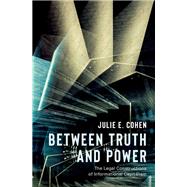
Between Truth and Power
by Julie E. CohenRent Textbook
Rent Digital
New Textbook
We're Sorry
Sold Out
Used Textbook
We're Sorry
Sold Out
Summary
In Between Truth and Power, Julie E. Cohen explores the relationships between legal institutions and political and economic transformation. Systematically examining struggles over the conditions of information flow and the design of information architectures and business models, she argues that as law is enlisted to help produce the profound economic and sociotechnical shifts that have accompanied the emergence of the informational economy, it is too is transforming in fundamental ways. Drawing on elements from legal theory, science and technology studies, information studies, communication studies and organization studies to develop a complex theory of institutional change, Cohen develops an account of the gradual emergence of legal institutions adapted to the information age and of the power relationships that such institutions reflect and reproduce.
A tour de force of ambitious interdisciplinary scholarship, Between Truth and Power will transform our thinking about the possible futures of law and legal institutions in the networked information era.
Author Biography
Julie E. Cohen is Mark Claster Mamolen Professor of Law and Technology at the Georgetown University Law Center. Professor Cohen teaches and writes about privacy, surveillance, information platforms, intellectual property, and the governance of information and communication networks. She is also the author of Configuring the Networked Self: Law, Code, and the Play of Everyday Practice.
Table of Contents
Introduction
Part I. Patterns of Entitlement and Disentitlement
Chapter 1. Everything Old Is New Again-Or Is It?
Chapter 2. The Biopolitical Public Domain
Chapter 3. The Information Laboratory
Chapter 4. Open Networks and Closed Circuits
Part II: Patterns of Institutional Change
Chapter 5. The End(s) of Judicial Process
Chapter 6. The Regulatory State in the Information Age
Chapter 7. Networks, Standards, and Transnational Governance Institutions
Chapter 8. The Future(s) of Fundamental Rights
Conclusion
Acknowledgments
Endnotes
An electronic version of this book is available through VitalSource.
This book is viewable on PC, Mac, iPhone, iPad, iPod Touch, and most smartphones.
By purchasing, you will be able to view this book online, as well as download it, for the chosen number of days.
Digital License
You are licensing a digital product for a set duration. Durations are set forth in the product description, with "Lifetime" typically meaning five (5) years of online access and permanent download to a supported device. All licenses are non-transferable.
More details can be found here.
A downloadable version of this book is available through the eCampus Reader or compatible Adobe readers.
Applications are available on iOS, Android, PC, Mac, and Windows Mobile platforms.
Please view the compatibility matrix prior to purchase.
